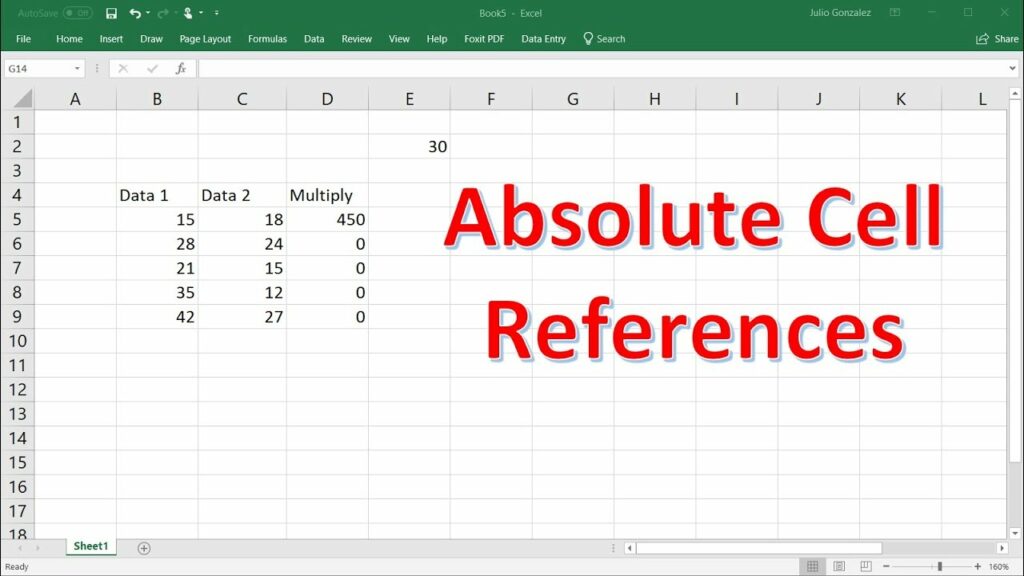How to Use Absolute and Relative References in Excel

Excel is a powerful tool for data analysis, and understanding how to use references effectively is crucial for maximizing its capabilities. Absolute and relative references are two types of references that allow you to create dynamic formulas and perform complex calculations with ease. In this comprehensive guide, we will explore the concepts of absolute and relative references in Excel, discuss their differences, learn how to use them in formulas, and explore practical examples and applications.
Table of Contents
- Introduction
- Understanding Absolute and Relative References
- How to Use Absolute References in Excel
- Absolute References Syntax
- Example of Absolute References
- How to Use Relative References in Excel
- Relative References Syntax
- Example of Relative References
- Mixed References: Combining Absolute and Relative References
- Mixed References Syntax
- Example of Mixed References
- Practical Applications of Absolute and Relative References
- Copying Formulas Across Rows and Columns
- Creating Dynamic Summaries and Reports
- Building Complex Models and Simulations
- Advanced Techniques for Working with References
- Using Named Ranges
- Using Indirect Function
- Using Table References
- Tips and Tricks for Working Efficiently with References
- Using Shortcut Keys
- Using Formula Auditing Tools
- Using Cell Styles for Reference Types
- Common Errors and Troubleshooting
- #REF! Error
- Circular Reference Error
- Incorrect Results Due to Reference Types
- Conclusion
1. Introduction
Excel’s ability to reference cells, ranges, and formulas dynamically is what makes it such a powerful tool for data analysis and modeling. Absolute and relative references are two types of referencing methods that determine how cell references behave when formulas are copied or moved. Understanding the difference between absolute and relative references, as well as when and how to use them, is essential for building accurate and efficient spreadsheets.
2. Understanding Absolute and Relative References
Absolute References:
- Definition: An absolute reference in Excel refers to a fixed cell or range that does not change when copied or moved.
- Symbol: Absolute references are denoted by a dollar sign ($) before the column letter and row number (e.g., $A$1).
- Behavior: Absolute references remain constant, regardless of where the formula is copied or moved.
Relative References:
- Definition: A relative reference in Excel refers to a cell or range that adjusts its position relative to the location of the formula.
- Behavior: Relative references change based on the formula’s new location when copied or moved to different cells.
3. How to Use Absolute References in Excel
Absolute References Syntax:
To create an absolute reference in Excel, simply add a dollar sign ($) before the column letter and row number of the cell reference.
Example: $A$1
Example of Absolute References:
Suppose you have a sales dataset with the total sales in cell A1 and the sales tax rate in cell B1. To calculate the total amount including tax, you would use an absolute reference for the sales tax rate:
swift
Copy code
= A1 + (A1 * $B$1)
In this formula, $B$1 is an absolute reference to the sales tax rate, ensuring that the tax rate does not change when the formula is copied to other cells.
4. How to Use Relative References in Excel
Relative References Syntax:
Relative references in Excel do not require any special symbols. Simply refer to the cell or range without any dollar signs.
Example: A1
Example of Relative References:
Suppose you have a dataset with sales quantities in column A and unit prices in column B. To calculate the total revenue for each transaction, you would use relative references:
Copy code
= A1 * B1
When this formula is copied to other cells, such as C2, it automatically adjusts to refer to the corresponding sales quantity and unit price in that row: = A2 * B2.
5. Mixed References: Combining Absolute and Relative References
Mixed References Syntax:
Mixed references in Excel contain a mix of absolute and relative components. You can fix either the column or row while allowing the other to adjust.
Example: $A1 or A$1
Example of Mixed References:
Suppose you have a dataset with sales quantities in column A and fixed unit prices in column B. To calculate the total revenue with a fixed unit price, you would use a mixed reference for the unit price:
swift
Copy code
= A1 * $B$1
In this formula, $B$1 is an absolute reference to the unit price, ensuring that it does not change when copied across rows but adjusts when copied across columns.
6. Practical Applications of Absolute and Relative References
Copying Formulas Across Rows and Columns
Absolute and relative references are essential for copying formulas across rows and columns while maintaining the correct references to data.
Creating Dynamic Summaries and Reports
By using a combination of absolute and relative references, you can create dynamic summaries and reports that update automatically as new data is added.
Building Complex Models and Simulations
Absolute and relative references enable you to build complex models and simulations that accurately reflect changes in input variables and assumptions.
7. Advanced Techniques for Working with References
Using Named Ranges
Named ranges provide meaningful names to cell ranges, making formulas easier to understand and manage.
Using Indirect Function
The INDIRECT function allows you to create references dynamically based on the contents of other cells.
Using Table References
Excel Tables automatically adjust references as data is added or removed, making them ideal for dynamic data analysis.
8. Tips and Tricks for Working Efficiently with References
Using Shortcut Keys
Learn and use Excel shortcut keys for quickly toggling between reference types and navigating through formulas.
Using Formula Auditing Tools
Excel’s formula auditing tools, such as Trace Precedents and Trace Dependents, help you visualize and understand complex formulas.
Using Cell Styles for Reference Types
Apply different cell styles or formatting to distinguish between absolute, relative, and mixed references visually.
9. Common Errors and Troubleshooting
#REF! Error
The #REF! error occurs when a formula contains an invalid reference, such as a deleted cell or range.
Circular Reference Error
A circular reference error occurs when a formula refers to its own cell directly or indirectly.
Incorrect Results Due to Reference Types
Incorrect formula results may occur if references are not used correctly, such as using absolute references when relative references are needed.
10. Conclusion
Absolute and relative references are essential tools for building accurate and dynamic spreadsheets in Excel. By understanding how to use these reference types effectively, you can create powerful formulas, analyses, and models that adapt to changes in data and assumptions. Whether you are a beginner or an advanced Excel user, mastering absolute and relative references will greatly enhance your ability to work with data and perform complex calculations in Excel. Through practical applications, advanced techniques, and troubleshooting tips, this guide has equipped you with the knowledge and tools to harness the full potential of absolute and relative references in Excel.







